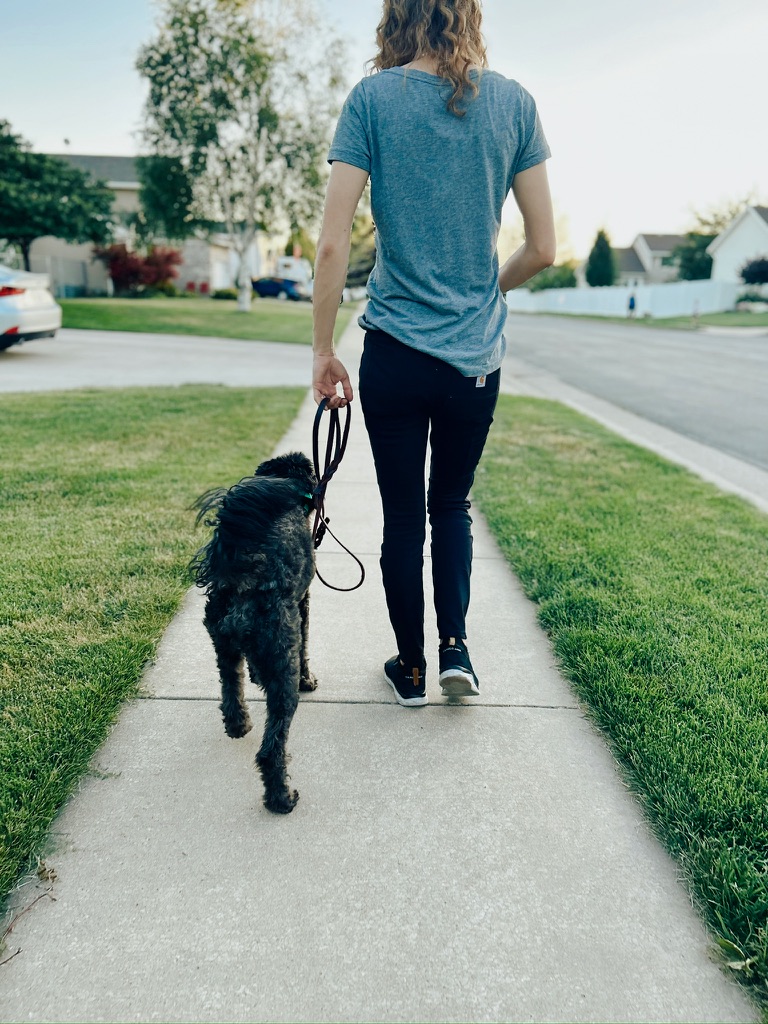How Do I Stop My Dog Barking on Walks?
If you’ve ever found yourself gripping the leash and muttering, “Please don’t bark this time…”—you’re not alone. You’ve probably asked yourself, ‘How do I stop my dog barking on walks’. We are here to tell you!
At Cornerstone Dog Training, we teach that barking on walks is rarely about being “naughty.” It’s usually about composure and focus. Once you understand what’s going on in your dog’s mind, you can help them handle the world with confidence—not chaos.
Why Dogs Bark on Walks
There’s always a root cause behind that bark. Here are a few of the most common:
- Overstimulation: Too many sights, sounds, or smells at once.
- Anxiety or fear: Other dogs, people, or moving vehicles can trigger defensive barking.
- Excitement: “Look, another dog! Let’s play!”
- Territorial behavior: Some dogs think every sidewalk belongs to them.
Whatever the reason, barking is your dog’s way of saying, “I don’t know what to do with all this energy.”
Step-by-Step- How to Stop My Dog Barking On Walks:
Step 1: Start with Composure Training
Before fixing barking, your dog needs to learn how to be calm in motion. This is where composure training comes in—helping your dog focus on you in the middle of distractions.
Start small:
- Practice “sit” and “down” in your living room.
- Gradually add small distractions like another person walking by.
- Reward calm behavior with food and praise.
Calm is a skill. The more your dog practices it, the more natural it becomes—even outdoors.
Step 2: Use the Leash to Communicate
If your dog barks, don’t pull the leash or start talking a mile a minute. That usually triggers what’s called opposition reflex—your dog’s instinct to push(or pull) against pressure.
Instead, use your leash like a communication tool, not a tug-of-war rope. A quick, calm flick on a loose leash gives direction without feeding tension. The goal is to redirect your dog’s focus—not punish them.
When the leash goes tight, your dog feels pressure. When it’s loose, they feel freedom. That rhythm of pressure and release helps your dog understand you’re in control of the situation, so they don’t have to be.
Step 3: Teach Eye Contact
When your dog looks at you instead of that barking trigger, you’ve already won. Eye contact builds trust and focus.
Here’s how to start:
- Hold a piece of food in your hand.
- Wait for your dog to look at your eyes—even for a split second.
- Mark it with a “Yes!” and reward.
Repeat this in calm environments before trying it on walks. Eventually, that quick glance toward you becomes their natural way of checking in before reacting.
Step 4: Practice the “Heel” Command
Walking politely by your side changes everything. When your dog is focused on heeling, they’re not scanning the horizon for something to bark at.
Start in a quiet area. Keep the leash loose. If your dog forges ahead, turn in the opposite direction. Reward when they match your pace and focus. Remember, short and positive walks build long-term habits.
Tip: Don’t worry about destination. You can practice this in your backyard for a few minutes! It is more of a dog dance than it is a walk when you are teaching the heel.
Step 5: Don’t Feed the Bark
This one’s big. When your dog barks at something and you respond with tension—pulling, yelling, or even soothing words, or food—you’re accidentally reinforcing the behavior.
Stay calm. Use your training tools, give direction, and follow through. Barking less is a byproduct of better focus, leadership, and composure.
Step 6: Gradually Add Distractions
Once your dog can focus in a quiet area, slowly add new environments:
- Your driveway
- The sidewalk
- The park during a quiet hour
- Then, busier times of day
Always end on a win. Keep your sessions short, lighthearted, and full of encouragement.
Step 7: Don’t Feed the Bark
Correction is not cruel. Correction is feedback. If your dog only hears “yes”, they won’t know what they aren’t supposed to do.
Think of starting a new job. Your boss always praises you when you do what you are supposed to. Let’s say you re-load the printer with paper, but it isn’t the right paper. If your boss didn’t correct you, you aren’t going to know how to do it properly.
Correcting your dog to stop barking on walks is not mean. It is building trust and your relationship.

The Cornerstone Secret
At Cornerstone Dog Training, we teach that focus kills chaos. When your dog learns to look to you for direction instead of reacting to the world around them, barking fades naturally. It’s not just correction—it’s connection. Start as a puppy with our Puppy Training Program
If your walks currently feel more like a battle than bonding time, you can absolutely change that. With the right structure and tools, your dog can walk calmly by your side—quiet, focused, and happy.
Ready for a Peaceful Walk?
Learn how to transform your walks from stressful to serene. Watch our free webinar to see exactly how we teach calm, focused behavior—no matter your dog’s age or breed.
Sign up for a Free Consultation here.
+ show Comments
- Hide Comments
add a comment